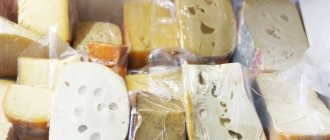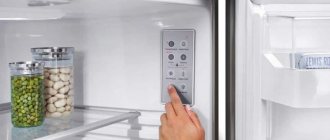If the refrigerator is constantly stocked with food, but it seems like there is nothing to eat, you should think about it and reconsider your habits. Proper storage will not only extend the shelf life of food, but will also help you make healthier choices. If you always have fresh vegetables and fruits in the house, the desire to snack on something harmful will be much less. These five tips will help preserve the taste and beneficial properties of your food longer.
Top 7 “forbidden” foods that prevent you from getting perfect abs
Containers and individual bags
If you store food together, and even without packaging, it can spoil faster. As soon as one apple or tomato begins to rot, the bacteria immediately spread to neighboring fruits and vegetables. In addition, the smells mix, and the refrigerator smells unpleasant.
Photo: istockphoto.com
This problem can be solved using special containers. Today, stores offer a large selection: plastic, glass and even wood. Ziploc sealed bags are also suitable. They take up less space than containers and are cheaper.
However, some products should not be stored in bags. It is better to transfer meat, chicken, fish and cheeses into containers or wrap them in foil.
It seems that a refrigerator is a completely ordinary household appliance, without which no kitchen can do.
Since ancient times, people have been puzzled by the preservation of food and increasing their shelf life - all kinds of cellars, glaciers, boxes of snow and barrels of cold water. And on August 8, 1899, inventor Albert Marshall patented a refrigerator. Now the approach to food preservation has been changed forever!
But many people still mistakenly perceive the refrigerator only as a source of cold, a “cabinet” in which food can be stored as desired. But due to improper storage, they quickly deteriorate, become stale, and acquire an unpleasant odor. Moreover, different modifications of refrigerators require different operation.
Types of refrigerators
Let's first figure out what kind of refrigerators there are. We will talk about ordinary household models.
Now on the supply market you can find a refrigerator of any size and color: two meters tall or huge, with hinged doors like a cabinet;
single-chamber (where there is only a refrigerator compartment or there is also a small freezer) or two-chamber (the refrigerator compartment and freezer are hidden behind different doors and sometimes have their own compressor - then you can defrost one chamber without interrupting the operation of the other).
When choosing, you can pay attention to the shelves : they can be metal lattice or solid plastic/glass. The grates provide better ventilation throughout the entire chamber; you can use them to hang bags or additional containers, but solid shelves are more convenient to use - if something spills, falls over, or falls apart in the refrigerator, the adjacent shelves (and the food on them) will not be damaged.
The refrigerator may not have the usual doors, but roll-out drawers, have built-in lighting, an ionizer, an ice-maker, an alarm clock and even a lock! And some models can be built into a kitchen set.
But regardless of design and class, all refrigerators can be divided into main categories:
- Refrigerators with manual defrosting
- Drip system or “crying” refrigerators
- NoFrost, FrostFree, “air”
Conventional refrigerators (which many are familiar with from Soviet times) require manual defrosting. Those. When you decide to get rid of the ice “coat” and do a general cleaning in this unit, turn it off from the power supply, take out all the food and leave it with the door open for the natural melting of the “glaciers”.
The drip system forms condensation from moist air. Moisture flows down the wall into a special hole and goes into the tray under the compressor. Because the compressor is hot enough, the water evaporates from the tray over time. Almost 100% humidity is maintained in the refrigerator compartment and the products do not air or dry out, and at the same time, odors do not accumulate here. Unwrapped greens can sit in a jar of water for weeks. Such refrigerators are very popular among confectioners, where they store their sweet masterpieces.
NoFrost – literally “without frost”. Such a refrigerator must be defrosted... never! The cold there is formed due to the circulation of cold air, and excess humidity is removed, so an ice “coat” does not form in the freezer compartment, and the products are not covered with frost. In the chamber of such a refrigerator, everything must be stored in hermetically sealed form, because... Due to the constant operation of the fan, the air dries out and the food becomes aerated. But there is an undeniable plus - all maintenance of such a refrigerator is reduced to simply wiping the shelves with a damp cloth as they become dirty.
Zones in the refrigerator
But no matter what kind of freezing and cooling system your refrigerator has, it is very important to use its space correctly so that food remains fresh and healthy for as long as possible.
- On the shelves:
In the user manual for any refrigerator you will find the manufacturer's recommendations on the correct placement of food. This advice is given for a reason. The refrigeration chamber maintains its own temperature regime at different points.
The back wall is the coldest place, its door is the warmest. It is recommended to store fermented milk products, cheese, eggs on the top shelf, ready-made and semi-finished products a little lower, and raw meat and fish at the very bottom (so that raw products do not drip onto already cooked ones).
- Freshness zone
Many modern refrigerators are equipped with special compartments with a reduced (zero) temperature - usually these are drawers and baskets at the bottom of the refrigerator compartment. These areas also maintain optimal humidity for long-term storage of fruits and vegetables. It is also recommended to store any perishable foods - greens, cheeses, seafood.
- refrigerator door
This is the warmest place in the refrigerator compartment. Products with a short shelf life (such as milk and cheese) should not be stored here. An exception is butter, if the refrigerator door is equipped with a special compartment or container with additional heat protection. But for bottles of drinks and cans with already opened preserves, this is an ideal place.
We arrange products
Now how can you arrange food in the refrigerator as ergonomically as possible?
It is especially important to organize proper food storage during the holidays, when large-scale purchases of ingredients are made, and then the shelves are stocked with ready-made dishes.
- Plan
To maintain order in the refrigerator, plan a menu for 2-3 days, a week or even a month - you will always have food items for cooking at hand (you can create a menu on a special magnetic
planner, which is convenient to “stick” on the refrigerator door, and immediately record the necessary purchases).
In the store, buy products strictly according to the list, this way you will avoid the problem of uneaten and forgotten in the far corners of the refrigerator (plus saving your budget from buying thoughtless goodies).
When filling the refrigerator, it is immediately convenient to divide the food into portions, put them in bags, leave some for further cooking over the next couple of days, and freeze the rest.
- Finished Products
It is best to store ready-made dishes and ingredients for future cooking in special food-grade plastic containers (see markings on the bottom) or enamel dishes with tight lids; utensils made of surgical steel are also suitable. Anything that cannot be put into containers is best packed in foil, cling film or bags ( zip-lock bags - they are reusable, come in different sizes and are suitable for freezing).
Dense packaging will not only extend the shelf life of products, but will also prevent odors from mixing, and the products will not lose their taste and appearance for a long time.
- Let's make the most of the space!
For storage, choose square containers. And this is not the advice of a perfectionist - square and rectangular containers will ergonomically fill the space of the refrigerator - a dozen of these containers will fit on a shelf more compactly than a couple of saucepans. In addition, square and rectangular containers hold more food than round ones.
If you use many identical containers, label them so that it is convenient for each family member to find what they need. This is especially true for containers in the freezer, because... It can be quite difficult to distinguish a piece of white fish from a chicken fillet.
You can make notes directly on the lid with a washable marker, glue pieces of masking tape with notes, or use special stickers .
Another tip: store large jars and tall containers at the back wall, then place medium ones, and small ones from the very edge - this gives a better overview, and nothing from the food will be forgotten.
- Separate storage
Carefully study the issue of separate food storage! Raw meat and fish should not be placed next to already cooked dishes, because this can serve as a source of infection. It is also worth storing fruits and vegetables in different containers or boxes, because... they can accelerate each other's decay. The fact is that some vegetables and fruits emit ethylene gas, which promotes rapid ripening and accelerates the spoilage of other products. For example, apricots, tomatoes, bananas have a “bad effect” on apples, eggplants and potatoes.
Some vegetables and fruits are not recommended to be kept in the refrigerator at all, because... this shortens their shelf life. For example, potatoes can darken and become sweet if the chamber is too humid, onions and garlic should always have access to fresh air, and tomatoes are best stored wrapped in newspaper at room temperature.
To get rid of bags and nets with these vegetables, you can store them in special containers that will look beautiful in any corner of the kitchen.
In addition, it is not recommended to store cheeses and smoked products, as well as sausages and herbs nearby in the refrigerator, because strong odors penetrate very well into products with a more delicate taste, and honey (it crystallizes), chocolate (covers with a white film) and olive oil (thickens and hardens) cannot be stored there.
- Conservation
You should not store all kinds of jars with homemade preparations and store-bought canned goods in the refrigerator. It is understood that canned food already has a long shelf life, and they should only be kept in a cool, not cold, place. In addition, a large number of cans can interfere with normal air circulation and the temperature regime will be disrupted, and this can have a negative impact on other products.
- Purity
Always keep the shelves clean and wash the refrigerator regularly (experts advise doing this at least twice a month). For boxes with vegetables and fruits, it is advisable to use a special antibacterial mat; moreover, such a mat creates an additional air layer, and the products last longer.
You can also cover each shelf with cling film, which needs to be changed from time to time, and if something spills, the consequences of the accident and the cleaning time will be minimal.
To eliminate unpleasant odors, you can put a bowl of salt in the refrigerator (it needs to be changed from time to time) or put an unpackaged lemon on the shelf.
You can also prepare an aqueous solution of baking soda and lemon juice, place a sprig of rosemary there and wipe the shelves with this water - not only cleanliness, but also a pleasant fresh smell is guaranteed!
- Lifehacks
How often have we come across advice: “To keep bananas longer, wrap the base of the bunch with cling film”, “To prevent the cheese from drying out, grease the cut with butter” or “Potatoes will not germinate if you store them mixed with apples.” But what really? What working tricks are found in real refrigerators of ordinary people?
Storing ready meals
Olya: “Sometimes there is no time to put everything into containers, but there are a bunch of bowls covered with plates - all the dishes are collected in the refrigerator. Look in supermarkets for special caps for bowls, they are rare, but so convenient!”
Oksana: “and they told me to use the caps that catering workers put on their heads, such thin fabric and breathable ones. They cost pennies, are sold in professional cosmetics stores, and can be used to cover ready-made salads, cold cuts, and wide-necked jars.”
Greenery
Elena: “I store greens and fresh bay leaves in Ikea zip bags.”
Irina: “Bunches of lettuce are usually sold in open bags and if you don’t use them right away, they quickly wither. My mother-in-law taught me a tricky way - wash the leaves, dry them thoroughly, tear them into large pieces and place them in portions in jars with tight lids (you can also put them in bags). It doesn’t last long, but a couple of days longer than in a store-bought bag.”
Elena: “I have a special container for greens - you put a little water inside and the greens sit for weeks. These things come in different shapes and brands.”
Anastasia: “I love fresh greens. I buy a large bunch, put it in a jar of water, cover it with a bag, make a small hole in it, tie it around the jar and put it in the refrigerator. I can have a bunch like this for three weeks and it will be as fresh as fresh from the market.”
Svetlana: “I didn’t know such a trick about salad! I'll try! I store dill and parsley according to this principle, the main thing is to dry all the leaves thoroughly, then the greens will not spoil for a long time even in a tightly closed jar.”
Eat immediately!
My discovered and successfully used life hack is a special basket on the most visible shelf, where products with expiring dates are stored. Whenever you want some goodies, you can first rummage through this basket.
We use everything!
If your refrigerator has shelves in the form of bars, then this is a godsend especially for you! Small bags of food can be secured to the bars using regular office clips. How do you like this vertical storage? And who said that this only happens in the closet?
If there is some sauce left on the bottoms of the bottles, many people store these bottles with the neck down so that it is convenient to get out the leftovers. The only problem is that everything is so unstable. For convenient storage, you can use cardboard egg packaging.
Even if all the shelves are hopelessly packed, there is always free space on the walls of the refrigerator! Attach pockets or light shelves with suction cups there (these are common inexpensive accessories for the bathroom) and put small bags and small jars there, then these little things will definitely not get lost on the shelves.
Oksana: “If you store a lot of small jars in the refrigerator, then you have to stack them on top of each other to save space. I saw some advice in some online newsletter: put additional plastic shelves . And it’s really convenient!”
To summarize this article, I would like to draw your attention to the following important details:
- Do not place the refrigerator near stoves or heating appliances
- Do not place hot foods in the refrigerator compartment (unless otherwise specified in the manufacturer's instructions)
- Do not leave the door open for too long
- Connect this unit only to a grounded outlet.
If you follow these minimum rules, take care of your friend with an icy heart and properly place food on the shelves, then the refrigerator will serve you for a very long time.
And in one of the following articles I will continue the conversation about the refrigerator, but will dwell in more detail on the topic of the freezer and freezing food.
Greens, vegetables and fruits along with paper
Many vegetables and fruits rot quickly in the refrigerator. This is due to increased humidity levels, since not all refrigerators provide a special area for storing these products. Therefore, to prolong their freshness, you can put paper napkins with them or even store herbs, vegetables and fruits in paper bags. They will absorb condensation and prevent moisture from accumulating.
Also, vegetables and fruits should be stored separately if possible. Many fruits (apples, pears, peaches, etc.) emit ethylene gas, which accelerates the spoilage of vegetables. Carrots, broccoli, asparagus and lettuce are especially sensitive to it.
Secret Weapon: How Fruit Helps Fight Obesity
Storing vegetable oil
Refined vegetable oil should be stored in the refrigerator. Since the fats in the oil begin to deteriorate in the heat, the oil will quickly acquire a bitter taste.
The oil is lucky and can be left in a plastic bottle; there is no need to pour it into a glass container!
And unrefined oil should be stored in a dark place in the kitchen and under no circumstances in the refrigerator, because the wax that is in the oil will precipitate and the oil will lose its quality.
Separate zones for different products
Few people think that the temperature inside the refrigerator is different and there are different zones for different products. So, the warmest place is the door. Although some are accustomed to storing milk and sour cream here, it is better not to do so. Leave the door on for juices, sauces, jams and preserves - they don't require particularly low temperatures to stay fresh.
Photo: istockphoto.com
The upper shelves are also quite warm. This is where you should store foods that are ready to eat, such as butter or yogurt, and leftovers from cooked food. The middle shelves are suitable for milk, cottage cheese, cheeses and eggs. The bottom shelves are usually the coldest: it is better to store meat, fish, chicken and other perishable foods here, but they must be packed.
In addition, many modern refrigerators are equipped with a so-called zero zone. It is designed specifically for storing fruits, vegetables, herbs and fresh herbs.
Top products you need to buy to make self-isolation delicious
Freezer
Frozen foods are stored here: meat and fish, berries, vegetables, herbs, ice cream.
Use special freezer bags. It is always easier to pack food in a regular plastic bag, but it is too thin, easily spoiled by the cold and allows air to pass through. Special freezer bags are made of material resistant to negative temperatures, which will protect their contents from drying out and the unpleasant smell of the freezer.
Sign packages. Did you have to guess how old the bag of minced meat that rolled into the far corner of the shelf was? To always know what is where and for how long, mark the workpieces. You can buy a CD marker and write directly on the bag, or you can use paper price tags or pieces of textile-based roll-up adhesive.
Magnetic marker holders Vladimir&Kazimir $28
Do not make blanks in the form of balls. It is better to freeze minced meat or berries in the form of a relatively flat briquette, this will make them easier to store and easier to defrost.
Regular “audit” and cleaning
If you prefer to buy food for future use and load the refrigerator, for example, once a week, it is worth conducting a regular “audit”. Check not only the expiration date, but also the condition of the food: sometimes it can go bad, even if the date on the package says otherwise.
Photo: istockphoto.com
Also, don't forget to clean your refrigerator thoroughly. This way, the food will stay fresh longer, and the device itself will better maintain the temperature and consume less electricity.
Not for refrigerator
It would seem that the shelf life of any food increases if you store it in the refrigerator. However, this is not quite true. Some, on the contrary, retain their taste and freshness better if kept at room temperature. These include potatoes, watermelons, melons, garlic, onions, as well as chocolate, tea and coffee. In addition, you can store apples and unripe fruits without a refrigerator - this way they can ripen after purchase.
For five more life hacks that will help you lose weight without training, watch the “Championship” video.
If you properly store food and prepared healthy food, the temptation to eat something harmful will appear less often. After all, when there is tasty and healthy food in the refrigerator, you no longer want to break your diet for the sake of a fatty bun or chips.
Commodity neighborhood
Only the lazy have not heard about the importance of observing the rules of commercial neighborhood. Here are approximate instructions for storing food in the refrigerator:
- Under no circumstances should cooked and uncooked food be placed side by side. The latter often contain a huge variety of pathogenic bacteria, which easily spread to already prepared food and can cause acute poisoning of the body.
- Milk and its derivatives, like a sponge, absorb odors, so they should be protected from proximity to strong-smelling products.
- Isolate other neighbors from smoked cheeses, meats and sausages.
- The aroma of fish is very intrusive, so place it in a closed container.
Important! Eggs are a high-risk product. Their shells contain numerous pathogenic microbes and organisms that move around with ease.











